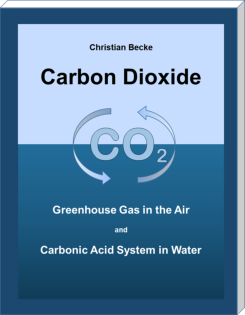Anker

Contents of the textbook
Contents
1
Properties of carbon dioxide
1.1 General data 1.2 Molecular structure 1.3 Radiation absorption2
The importance of carbon dioxide
2.1 Carbon dioxide as the basis of life 2.2 CO 2 as a greenhouse gas 2.3 The carbon footprint 2.4 The carbon balance of the earth3
Carbon dioxide content of air
3.1 Carbon dioxide in the atmosphere 3.1.1 Historical development of the CO 2 content of the atmosphere 3.1.2 The inorganic carbon cycle 3.1.3 The organic carbon cycle 3.1.4 Measurements of the CO 2 content of the atmosphere 3.1.5 Current situation 3.2 Carbon dioxide in the soil air4
The carbonic acid system in water
4.1 Solution of gaseous CO 2 in water 4.2 CO 2 and the pH value of natural waters 4.3 Chemical reaction with water - the carbonic acid forms 4.4 The simplified carbonic acid system 4.5 The Equilibrium constants 4.5.1 Formation of carbonic acid (hydration) 4.5.2 The dissociation constants of carbonic acid 4.5.3 Proportions of carbonic acid forms 4.6 Buffering 4.7 Solution of lime in water 4.7.1 Preliminary note on lime 4.7.2 Lime solution5
The importance of CO
2
in the water cycle
5.1 Weathering 5.2 Rainwater 5.3 Leachate 5.4 Groundwater 5.5 Spring water 5.6 Running waters 5.7 Lakes 5.7.1 Carbon cycle in standing water 5.8 World Oceans 5.9 Raw water for drinking water treatment 5.10 Cold water geysers 5.11 Hardly soluble carbonates6
Thought model for carbonic acid in water
6.1 Open system 6.2 Closed system7
Basics for calculations
7.1 Calculation of the constants in the carbonic acid system 7.1.1 Solubility constants for CO 2 7.1.2 The equilibrium constants in the base system 7.2 Analytical detection of carbonic acid forms 7.2.1 TIC and DIC 7.2.2 Determination of acid and base capacity 7.2.3 m-value and p-value 7.2.4 Equivalence factor 7.3 Calculation of the buffering intensity 7.4 The importance of temperature 7.5 Consideration of ionic strength and activity 7.6 Complexation reactions 7.7 Consideration of the m-value with complex formation 7.8 Summary of the required analysis data8
Evaluation variables for the carbonic acid system
8.1 Saturation pH value after adjustment with calcite (pH C ) 8.2 Saturation pH value after carbon dioxide exchange (pHA) 8.3 Saturation pH value according to STROHECKER/LANGELIER (pH L ) 8.4 Delta pH value (ΔpH) 8.4.1 Measurement of the ΔpH value 8.5 Saturation index SI 8.6 Calcite dissolving capacity and calcite separation capacity9
Water treatment
9.1 Deacidification in drinking water treatment 9.1.1 Legal regulations 9.1.2 Basics of deacidification 9.1.3 Physical deacidification 9.1.4 Chemical deacidification 9.1.5 Examples of process variants 9.1.6 Chemical reactions in the deacidification processes 9.1.7 Final pH values of different deacidification methods 9.2 Decarbonization / Softening 9.2.1 Delimitation of terms 9.2.2 Precipitation process 9.2.3 Ion exchange process 9.2.4 Membrane process 9.2.5 Effects of the procedures10
Sample calculations
10.1 Carbon content of the atmosphere 10.2 CO 2 concentration in the air 10.3 Solubility of CO 2 in water 10.4 Solution of CO 2 in leachate 10.5 pH value of a CO 2 solution 10.6 Supplementary consideration of the lime-carbonic acid system 10.7 Calculation of the carbonic acid content 10.7.1 Calculation of carbonic acid contents with complex formation 10.8 Thought model for carbonic acid in water: Open system 10.9 Calculation of the carbonic acid shapes from the TIC 10.10Acid capacity of pure water 10.11 Saturation index11
Chemical Basics in Brief
11.1 Basic terms and concentration information 11.2 Ionic strength and activity 11.3 The law of mass action 11.4 pH value 11.5 Acids 11.6 Buffering 11.7 The solubility product12
Tables
12.1 Values for the HENRY constant 12.2 Base constants as a function of temperature 12.3 Proportions of carbonic acid forms as a function of pH value 12.4 Constants of the complexation of calcium 12.5 Constants of the complexation of magnesium13
Formula symbols and abbreviations
14
Bibliography
15
Keyword index
Order
directly from the
publisher
Kohlendioxid
ISBN
: 978-3-7578-2450-1


Carbon Dioxide
ISBN
: 978-3-7578-9032-2











